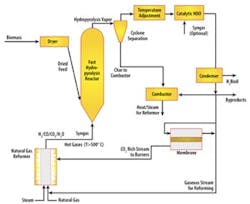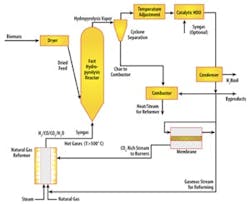Researchers Rethink Biomass Processing
Rather than bringing agricultural wastes and other suitable biomass to a processing facility to make biofuels, researchers at Purdue University, West Lafayette, Ind., propose to bring the processing plant to the biomass. They have developed a method — fast hydropyrolysis hydrodeoxygenation (Figure 1) — amenable to small mobile processing plants.
"Material like corn stover and wood chips has low energy density. It makes more sense to process biomass into liquid fuel with a mobile platform and then take this fuel to a central refinery for further processing…," explains Rakesh Agrawal, professor of chemical engineering.
The process, dubbed H2Bioil, involves heating biomass to as high as 500°C in less than a second in the presence of hydrogen in a high-pressure reactor, followed by catalytic oil-upgrading steps such as hydrodeoxygenation and carbon-carbon bond coupling, to yield a high-energy-density liquid fuel. Light gases such as methane, carbon dioxide, hydrogen and carbon monoxide are recycled. The hydrogen would come from natural gas or the biomass itself, notes Agrawal.
Traditional fast pyrolysis schemes run at atmospheric pressure in an inert atmosphere. Using hydrogen and high pressure for the pyrolysis and immediately upgrading the liquid raises the energy density of the oil produced, increases its stability for transportation and makes it more compatible with traditional refining operations, he says.
"The method is capable of processing all types of available biomass. The quantity of biofuel produced using H2Bioil is estimated to be two-to-three times the output from conventional processes," adds Agrawal.
Current experiments focus on reactor design for fast hydropyrolysis and catalyst development for hydrodeoxygenation. "We expect to have the high-pressure hydropyrolysis reactor online and preliminary results this fall."
Agrawal expects the unit to be small enough to fit on a flatbed truck. "We envision a unit will have a small steam/natural gas reformer and the exhaust from the reformer tubes will be directly fed to the fast hydropyrolysis reactor."
"Having a mobile unit will eliminate most of the costs with transporting the low-energy-density biomass from the source to the plant. We will certainly look forward to working with an entity who would be interested in building a pilot plant," he says.
Units should be commercially available in three to five years, Agrawal hopes.

